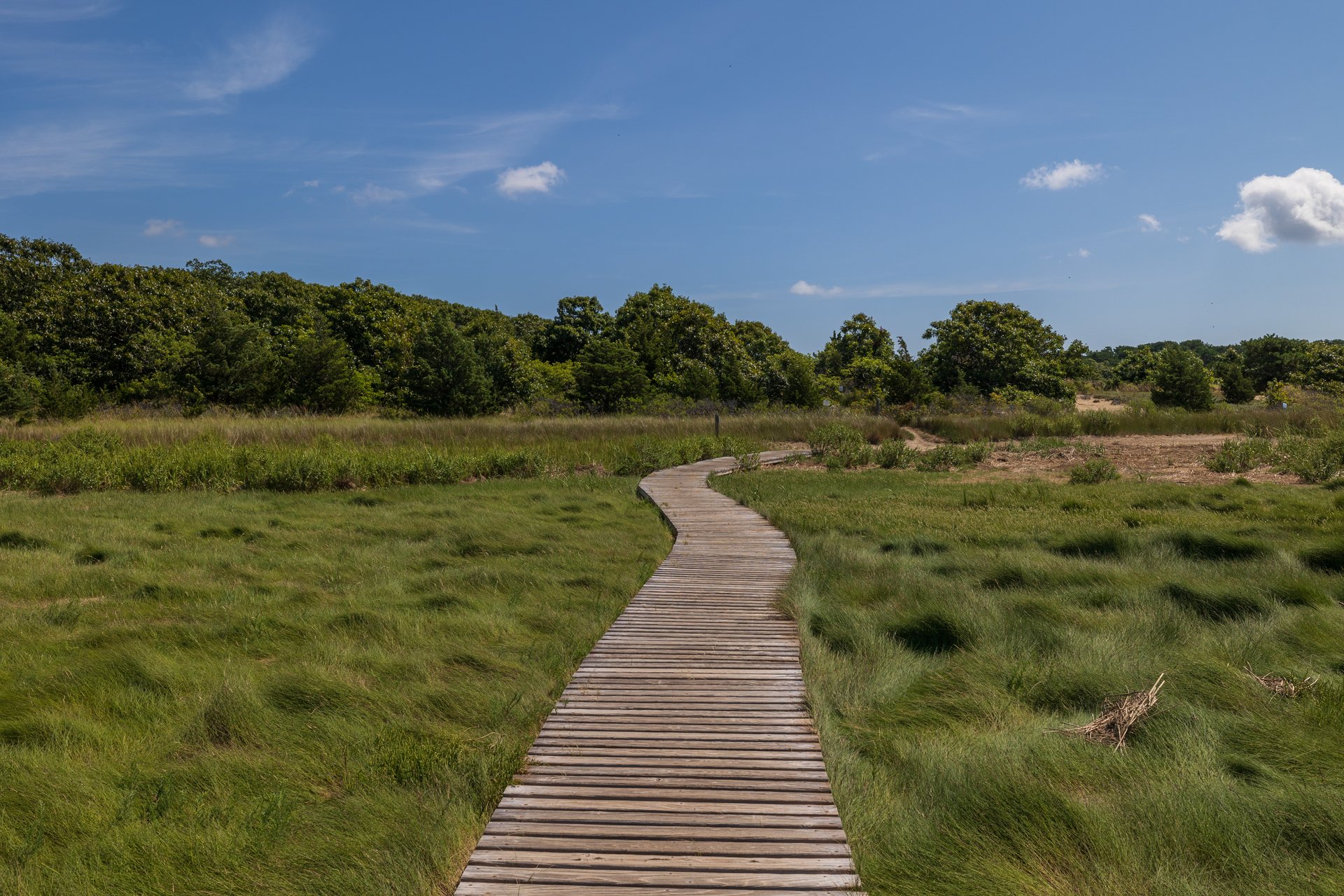Cape Cod
The coast is calling at our 6 wildlife sanctuaries on Cape Cod that are open to the public. Here you can explore everything from salt marshes to barrier beaches to pine woodlands.
Nature Centers & Trails
Long Pasture Wildlife Sanctuary, Barnstable
Sandy beaches, butterfly-filled meadows, woodland trails, farm animals, and gentle, varied trails lead to Barnstable Harbor flanked by the dunes of Sandy Neck Barrier Beach and Cape Cod Bay. Explore Long Pasture
Wellfleet Bay Wildlife Sanctuary, Wellfleet
Find peace and unmatched beauty on the hillsides and shoreline overlooking Wellfleet Harbor and Cape Cod Bay. Extensive trails bring you to a panoramic salt marsh, sandy barrier beach, and pine woodlands. Explore Wellfleet Bay
Trails Only
Ashumet Holly Wildlife Sanctuary, Falmouth
Known for its 1,000 holly trees of 65 varieties, Ashumet Holly also features an eight-acre coastal plain pond, considered a globally rare natural community attracting over 30 species of dragonflies and rare pondshore wildflowers. Explore Ashumet Holly
Barnstable Great Marsh Wildlife Sanctuary, Barnstable
This sanctuary is part of the ecologically significant 3,800-acre Sandy Neck salt marsh and barrier beach system. Find expansive salt marsh views, two open ponds, shady oak woodlands, and numerous wildlife. Explore Barnstable Great Marsh
Skunknett River Wildlife Sanctuary, Barnstable
Walk the tree-lined trails to witness nature reclaiming former mill sites, explore a fragrant atlantic white cedar swamp, and look in the waterways for migrating American Eel. Explore Skunknett River
No Trails
Sampsons Island Wildlife Sanctuary, Barnstable
Piping Plovers, Least Terns, and Common Terns nest on the island which is designated as an Important Bird Area (IBA). Access to the island is limited to protect nesting areas. Learn about Sampsons Island
Not Ready for Visitors
Cotuit Bay Wildlife Sanctuary, Barnstable
2 acres
Cotuit Bay Wildlife Sanctuary is a small property in Barnstable that borders Cotuit Bay on Cape Cod, about a half mile north of Dead Neck/Sampsons Island.
Conservation Features: This small wildlife sanctuary is situated within a residential neighborhood and is comprised of salt marsh and shrubland habitats. Nearby beaches and marshes in this region are important breeding and staging areas for several coastal bird species, including the federally endangered Piping Plover. The best way to observe this property is from a kayak or canoe in Cotuit Bay.
Cuttyhunk Thicket Wildlife Sanctuary, Gosnold
9 acres
The two properties that make up this wildlife sanctuary are located in the town of Gosnold on Cuttyhunk Island, the westernmost of the Elizabeth Islands. In the early fall, Long Pasture Wildlife Sanctuary offers naturalist-guided cruises to the island.
Conservation Features: Much of this wildlife sanctuary is dense shrubland that includes a coastal bluff and beach on Vineyard Sound.
Egg Island Shoal Wildlife Sanctuary, Barnstable
6 acres
A small, mostly intertidal shoal within Hyannis Harbor in Barnstable.
Conservation Features: This property serves as a pre-migration fall staging area for up to 600-800 terns, as well as many shorebirds and gull species. The federally listed Roseate Tern, along with Common Terns, were reported to nest on Egg Island Shoal in the early 20th century. The best way to observe this property is from a canoe, kayak, or sailboat from within Hyannis Harbor.
Fresh Pond Wildlife Sanctuary, Dennis
8 acres
Fresh Pond Wildlife Sanctuary is near but does not directly border Fresh Pond in Dennis. The wildlife sanctuary does abut protected open space owned by the Dennis Land Trust, which connects to Dennis town conservation land bordering Fresh Pond. The total complex of protected land is about 70 acres, much of which is wooded swamp.
Conservation Features: Approximately one-third of this property is freshwater wetlands, and the remainder is forested. A small stream runs from the sanctuary toward the Bass River. The shallow marsh meadow is visible from the road and contains broad-leaved cattails, and common reed. The wooded swamp near the road includes red maple, sweet pepperbush, and highbush blueberry.
Indian Trail Wildlife Sanctuary, Barnstable
10 acres
One of a series of Mass Audubon properties bordering Barnstable Harbor in Barnstable, this small wildlife sanctuary abuts conservation land managed by the Barnstable Land Trust.
Conservation Features: The wildlife sanctuary is made up of salt marsh surrounded by coastal/barrier beach communities and a tidal creek. The tidal flats adjacent to the salt marsh—but not part of the wildlife sanctuary—are habitat for shorebirds, winter waterfowl, and horseshoe crabs.
Maraspin Creek Wildlife Sanctuary, Barnstable
3 acres
This small wildlife sanctuary within the Sandy Neck Barrier Beach System is made up of three parcels along Maraspin Creek, a tidal creek that flows into the Barnstable Inner Harbor. It is best viewed from the bridge on Millway Street over Maraspin Creek.
Conservation Features: Most of its area is salt marsh with a small amount of adjacent coastal bank. The salt marsh immediately fringing Maraspin Creek is almost all tall cordgrass and marsh hay. Smaller amounts of other marsh plants, such as spike grass, black grass, sea lavender, saltmarsh sea blite, and glassworts are scattered throughout the marsh. Although the Maraspin Creek salt marshes are not directly connected to the vast Barnstable Great Marsh (3,000+ acres), it is likely that birds and fish routinely move between these areas.
Outermost House Wildlife Sanctuary, Eastham
43 acres (now mostly submerged or intertidal lands)
On the shore of Nauset Beach in Eastham, Outermost House is now largely submerged due to erosion and shifting of the barrier beach as well as the migration northward of the tidal inlet that connects the Nauset estuary with the Atlantic Ocean. This site is adjacent to the lands of the Cape Cod National Seashore.
Conservation Features: This property provided inspiration for the publication of the Outermost House, an important book of American environmental literature. The author, Henry Beston, was a naturalist and writer who built a cottage at the site in 1925. Named the Fo'castle, the cottage was destroyed during the blizzard of February 1978.
Popponesset Spit Wildlife Sanctuary, Mashpee
5 acres
On the south shore of Cape Cod in Mashpee, this wildlife sanctuary is situated on the eastern end of the sandy peninsula that separates Popponesset Bay from Nantucket Sound. The remaining 12 acres of the peninsula are owned by Save Popponesset Bay, Inc.
Conservation Features: The wildlife sanctuary provides nesting habitat for coastal waterbirds of high conservation priority including Piping Plovers, Least Terns, and Common Terns. The wildlife sanctuary also serves as a pre-migration fall staging area for Common Terns and sometimes Roseate Terns as well as many shorebird species.
Rendezvous Salt Marsh Wildlife Sanctuary, Barnstable
10 acres
Rendezvous Salt Marsh is one of the Mass Audubon wildlife sanctuaries that border Barnstable Harbor in Barnstable. The wildlife sanctuary also abuts salt marsh owned by the Barnstable Land Trust.
Conservation Features: Aside from about an acre of coastal woodland, the sanctuary is mostly salt marsh dominated by tall cordgrass and marsh hay. The marsh offers habitat for the birds and fish that routinely move between nearby coastal habitats.
Sesuit Marsh Wildlife Sanctuary, Dennis
2 acres
This small wildlife sanctuary is part of a larger 80-acre area of protected salt marsh along Sesuit Creek in Dennis.
Conservation Features: Virtually all of the wildlife sanctuary is salt marsh dominated by typical New England salt marsh plants. Marsh animals observed at this site include ribbed mussels, mud fiddler crabs, and the salt marsh killifish. Diamondback Terrapins may also be found here.
Tern Island Wildlife Sanctuary, Chatham
28 acres
Located just off the town dock, this island in Chatham Harbor is protected from the open waters of the Atlantic Ocean by Nauset Beach but remains strongly influenced by changes in the Nauset Beach barrier island, which can result in altered wave and current patterns.
Conservation Features: Tern Island provides nesting habitat for Least Tern and Common Terns, two state-listed coastal waterbirds. It also serves as a fall migration rest stop for large numbers of shorebirds. The tidal flats north of the island are an important feeding area for migratory shorebirds, and the mussel beds surrounding the island support relatively large numbers of feeding American oystercatchers during the spring through fall. Uncommon species such as Whimbrels and Marbled Godwit, Hudsonian Godwit, and even a Bar-tailed Godwit have been regularly recorded at the island.



